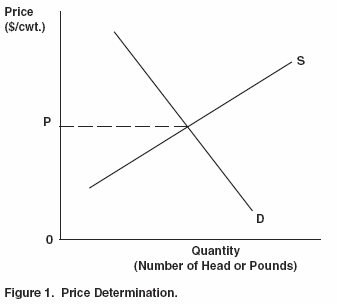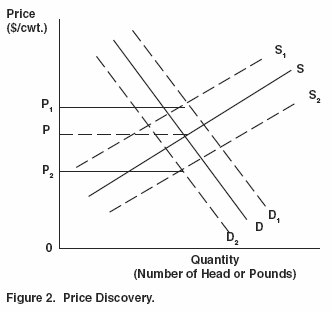



Low cattle prices are related to price determination factors.
By Clement E. Ward, Oklahoma State University - Ted C. Schroeder, Kansas State University and published by Oklahoma State University. Low prices result from supplies that are large relative to current beef demand conditions. Variation in week-to-week or daily prices across pens of cattle, both above and below the market price level, result from many factors directly affecting price discovery. Captive supplies, market information, and meatpacking concentration could be contributing causes.
Variation in week-to-week or daily prices across pens of cattle, both above and below the market price level, result from many factors directly affecting price discovery. Captive supplies, market information, and meatpacking concentration could be contributing causes.
Price discovery is frequently confused with price determination. These are two related, but different, concepts that need to be understood when discussing pricing issues. This fact sheet distinguishes between both concepts, identifies how they are interrelated, and provides an indication when price discovery concerns may increase.
Price Determination

Price determination is the interaction of the broad forces of supply and demand that determine the market price level. Figure 1 depicts a typical, textbook diagram for price determination. It shows the interaction of a supply curve (S) and demand curve (D) to determine the general price level (P). For fed cattle, supply determinants, or factors affecting the quantity of beef produced, include input prices (feeder cattle and grain), technology (growth promotants, etc.), and expected price of outputs produced from those inputs (fed cattle).
Broad demand factors affecting the amount of beef consumed include the price of products produced from fed cattle (beef), price of competing products (pork and poultry), consumer income, and consumer tastes and preferences.
Price Discovery
Price discovery is the process of buyers and sellers arriving at a transaction price for a given quality and quantity of a product at a given time and place. Price discovery involves several interrelated concepts, among them market structure (number, size, location, and competitiveness of buyers and sellers); market behavior (buyer procurement and pricing methods); market information and price reporting (amount, timeliness, and reliability of information); and futures markets and risk management alternatives.Price discovery begins with the market price level. Because buyers and sellers discover prices on the basis of uncertain expectations, transaction prices fluctuate around that market price level. Price discovery is more difficult to show graphically, but Figure 2 is an attempt. We begin with the same diagram as in Figure 1. Because of unknown information, buyers and sellers never know exactly the shape and location of the demand and supply curves. Therefore, buyers are willing to bid and sellers are willing to offer different prices on any given day. This is illustrated in Figure 2 by the dotted lines parallel to and on either side of the “true” supply (S1 and S2) and demand (D1 and D2) curves. Those estimated supply and demand curves intersect at a range of quantities and prices (P1 and P2). Thus, discovered prices fluctuate above and below the general or market price level (P). This fluctuation is attributable to the quantity and quality of the commodity brought to market, the time and place of the transaction, and the number of potential buyers and sellers present. Other factors might include the amount and type of public market information available, captive supplies, and packer concentration in the case of fed cattle prices.

One type of price discovery research attempts to determine factors that explain variation in transaction prices. In the 1970s, most fed cattle were priced on a live weight, cash market basis. Factors affecting fed cattle prices included: (1) carcass beef prices; (2) live cattle futures market prices; (3) cattle quality (including sex, weight, quality grade, and yield grade); (4) sale lot size; (5) number of days between purchase and delivery of cattle; (6) number of packers bidding on cattle; (7) individual packing plants or firms; (8) time of year; and (9) region of the country (Ward).
Many things have changed since the 1970s. Transaction prices for the same kind of price discovery research in the 1990s (Ward, Koontz, and Schroeder) included some modified and some additional factors: (1) boxed beef cutout values (instead of carcass beef prices); (2) live cattle futures market prices; (3) cattle quality (including sex, weight, quality grade, and yield grade); (4) sale lot size; (5) number of days between purchase and delivery of cattle; (6) individual packing plants or firms; (7) packing plant utilization; (8) day of the week; (9) time of year; and (10) extent and type of captive supplies. Since the mid-1990s, carcass weight and merit pricing programs, commonly referred to as grid pricing, have increased in importance. Thus, the base price used in grid pricing and the carcass premiums and discounts have become increasingly important in the price discovery process for fed cattle.
Price Discovery Interactions with Price Determination
Price determination and price discovery are interrelated. Price determination finds the market price level, which may be high or low. When market prices are low or are falling, questions and concerns about price discovery increase. Figure 3 is a matrix showing potential price discovery problems or concerns under given supply and demand scenarios. When demand is strong or expanding and when supplies relative to processing capacity are small or declining, price discovery problems are generally not a major concern. Under these conditions, competition is generally keen, thus ensuring efficient price discovery.
The opposite conditions have also occurred. Beef demand studies indicate consumer beef demand has been weak or declining for much of the past two decades. During the part of the cattle cycle when inventory numbers increase, beef supplies are large or expanding. Under these conditions, large supplies of cattle (beef) combine with weak or declining consumer (processor) demand. This causes low fed cattle prices and may heighten producersf price discovery concerns.
Compounding the problem at times has been large supplies of pork and poultry. The combined result is increased producer concerns about price discovery and accusations about captive supplies and packer concentration. Captive supplies and packer concentration (i.e., number of packers actively bidding) affect price discovery, i.e. transaction prices resulting from given market conditions. However, the market price level is not significantly affected by packer concentration or captive supplies (see extension facts WF-554, Packer Concentration and Captive Supplies).
Conclusion
The general level of prices reflects supply and demand factors. Individual transaction prices fluctuate around the general market price, whether it is high or low. The variation in transaction prices is related to many factors including quantity and quality of cattle and the timing and location of cattle sales/purchases.Thus, low prices are related to price determination factors, not price discovery factors. Low prices result from beef supplies which are large relative to the current beef demand conditions. Widely varying prices, both above and below the market price level, result from many factors directly affecting price discovery, of which captive supplies, market information, and meatpacking concentration could be contributing causes.
References
Ward, C.E. gShort.Period Pricing Models for Fed Cattle and Impacts of Wholesale Carcass Beef and Live Cattle Futures Market Prices.h Southern Journal of Agricultural Economics 13(1981):125.32.
Ward, C.E., S.R. Koontz, and T.C. Schroeder. Short-Run Captive Supply Relationships with Fed Cattle Transaction Prices. U.S. Department of Agriculture, Grain Inspection, Packers and Stockyards Administration, May 1996.
May 2007


